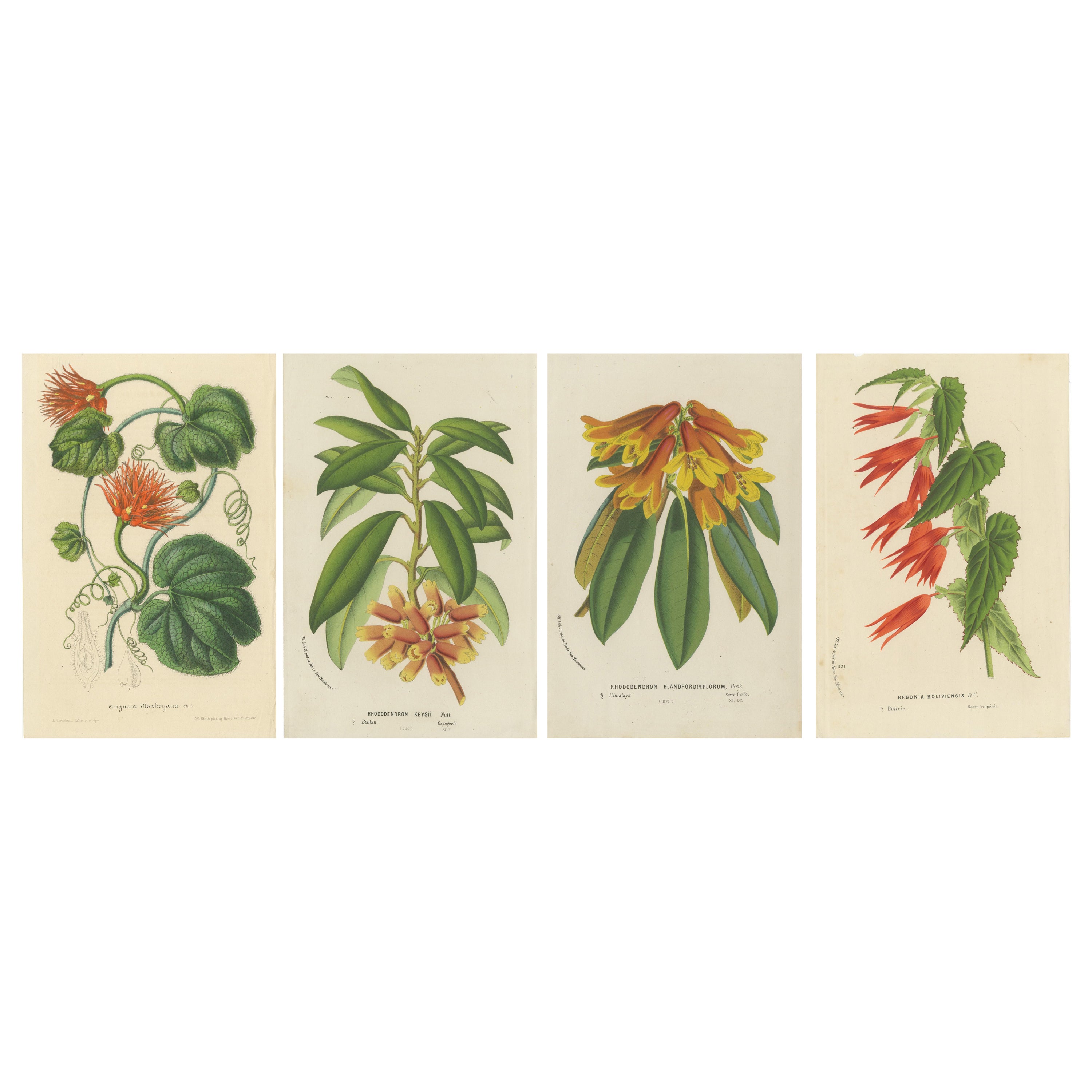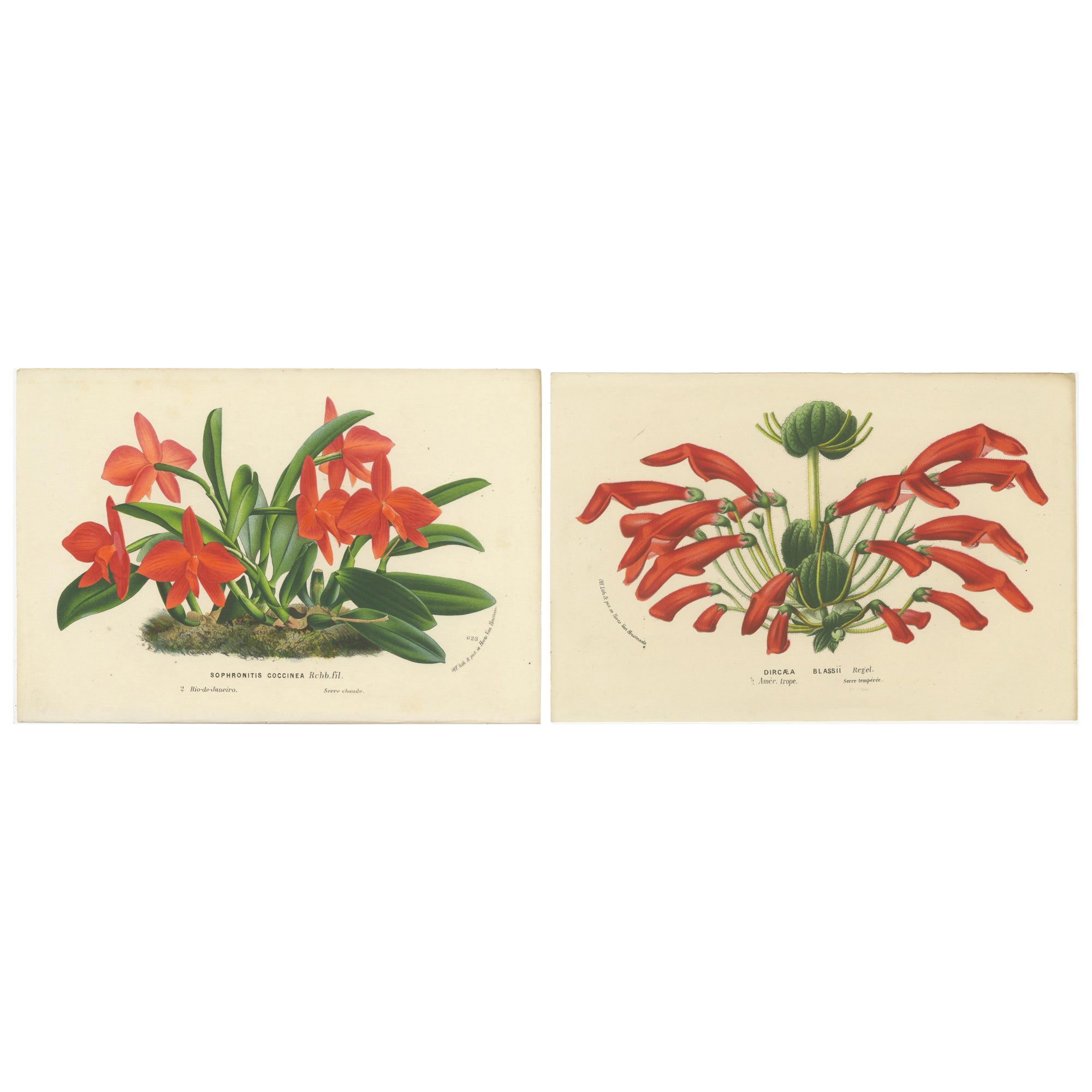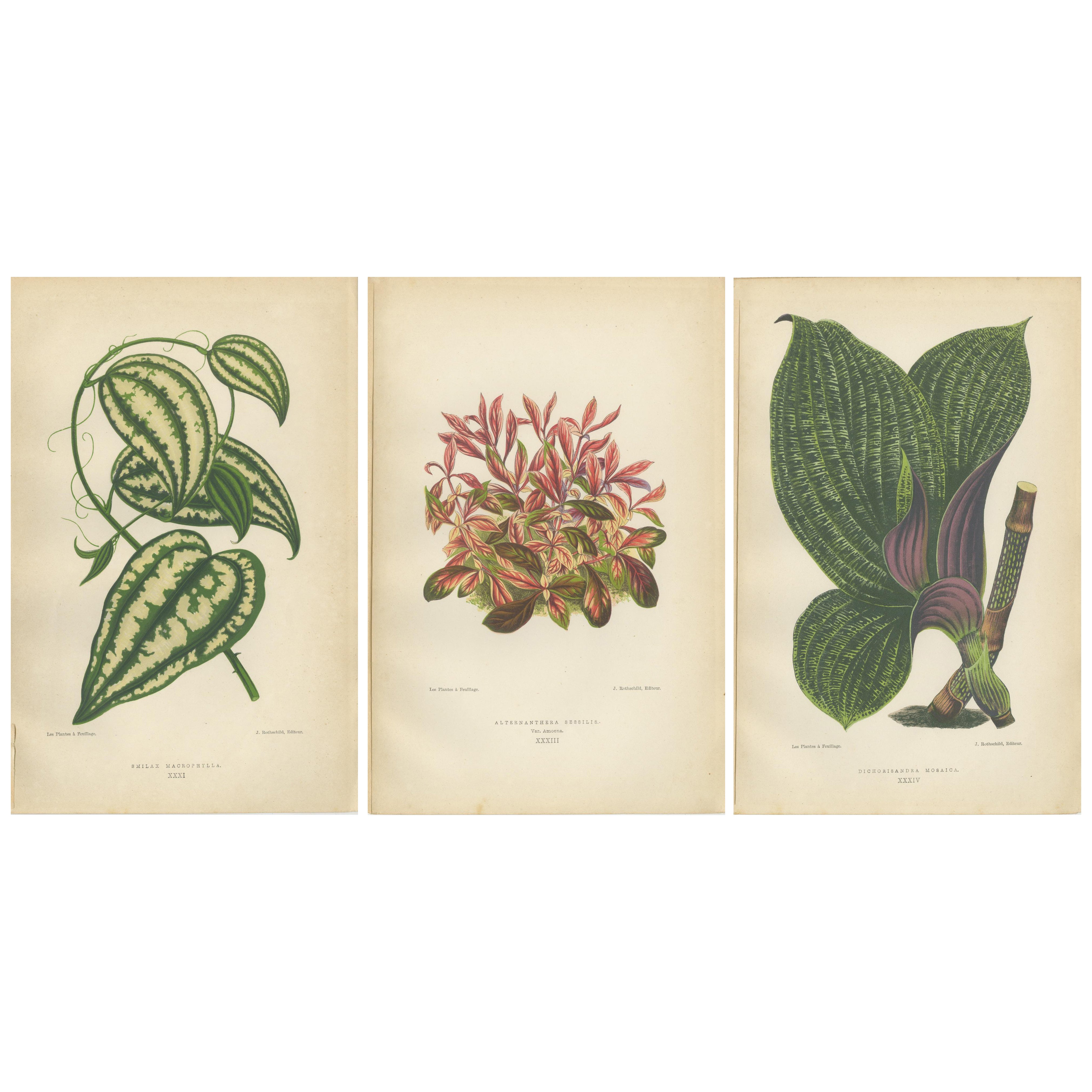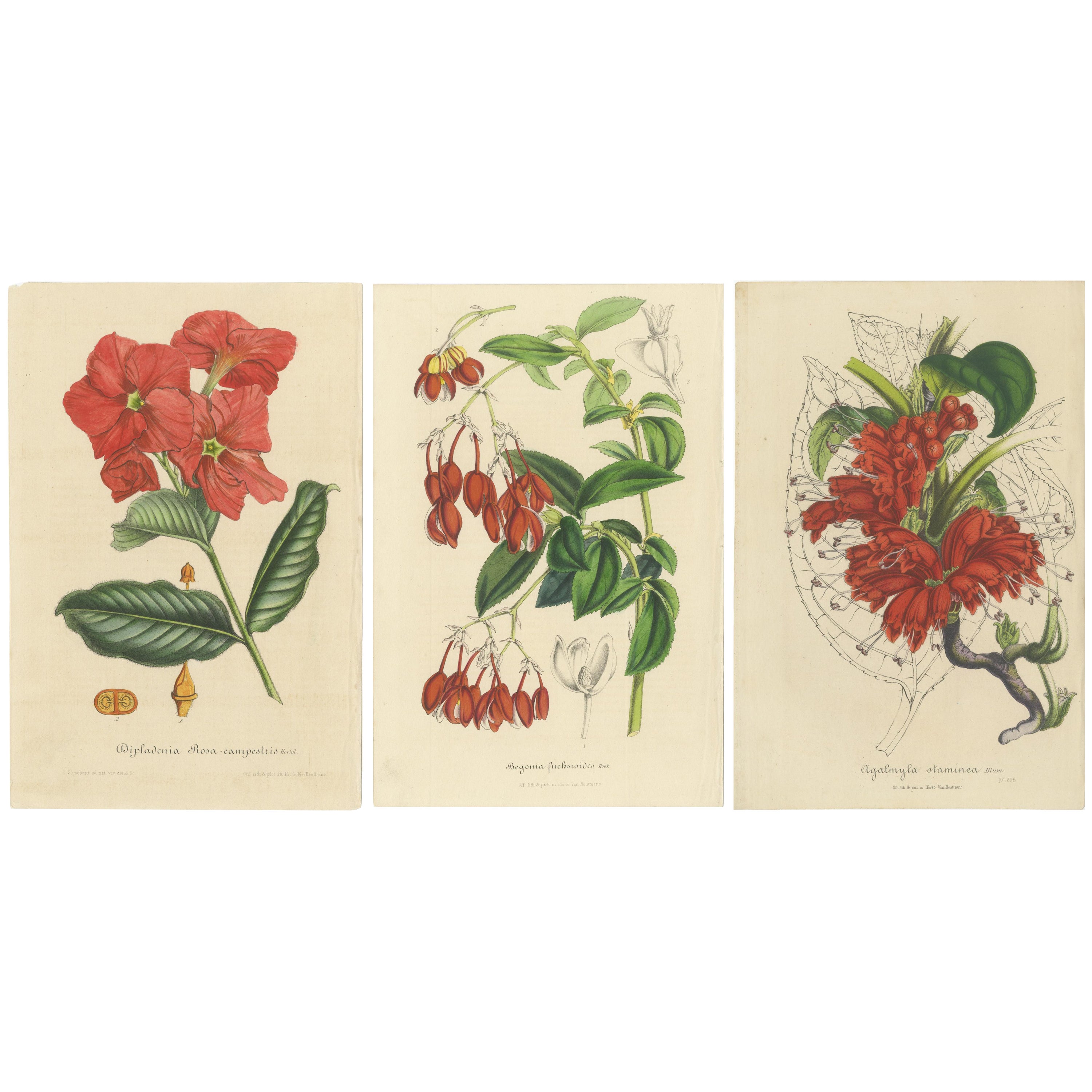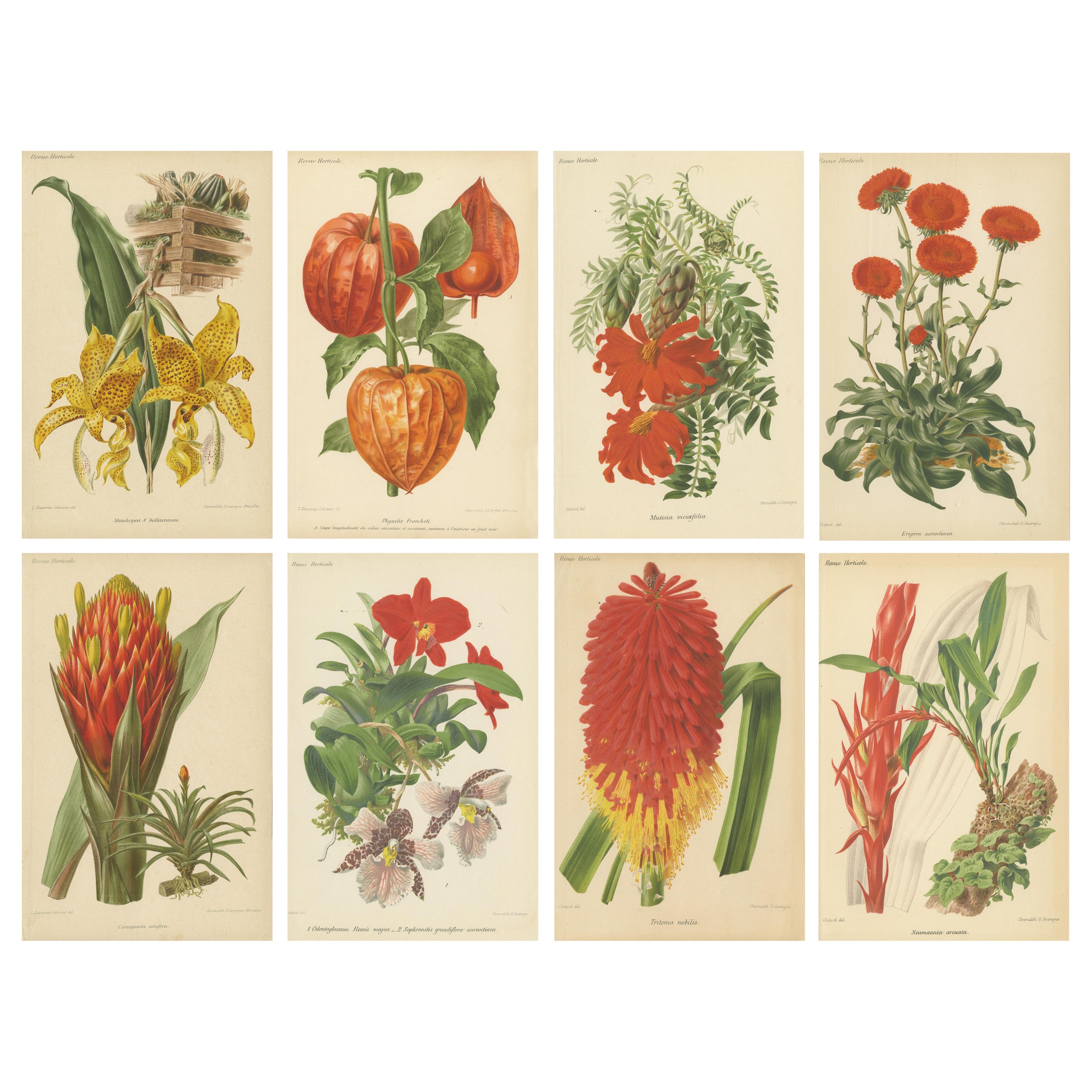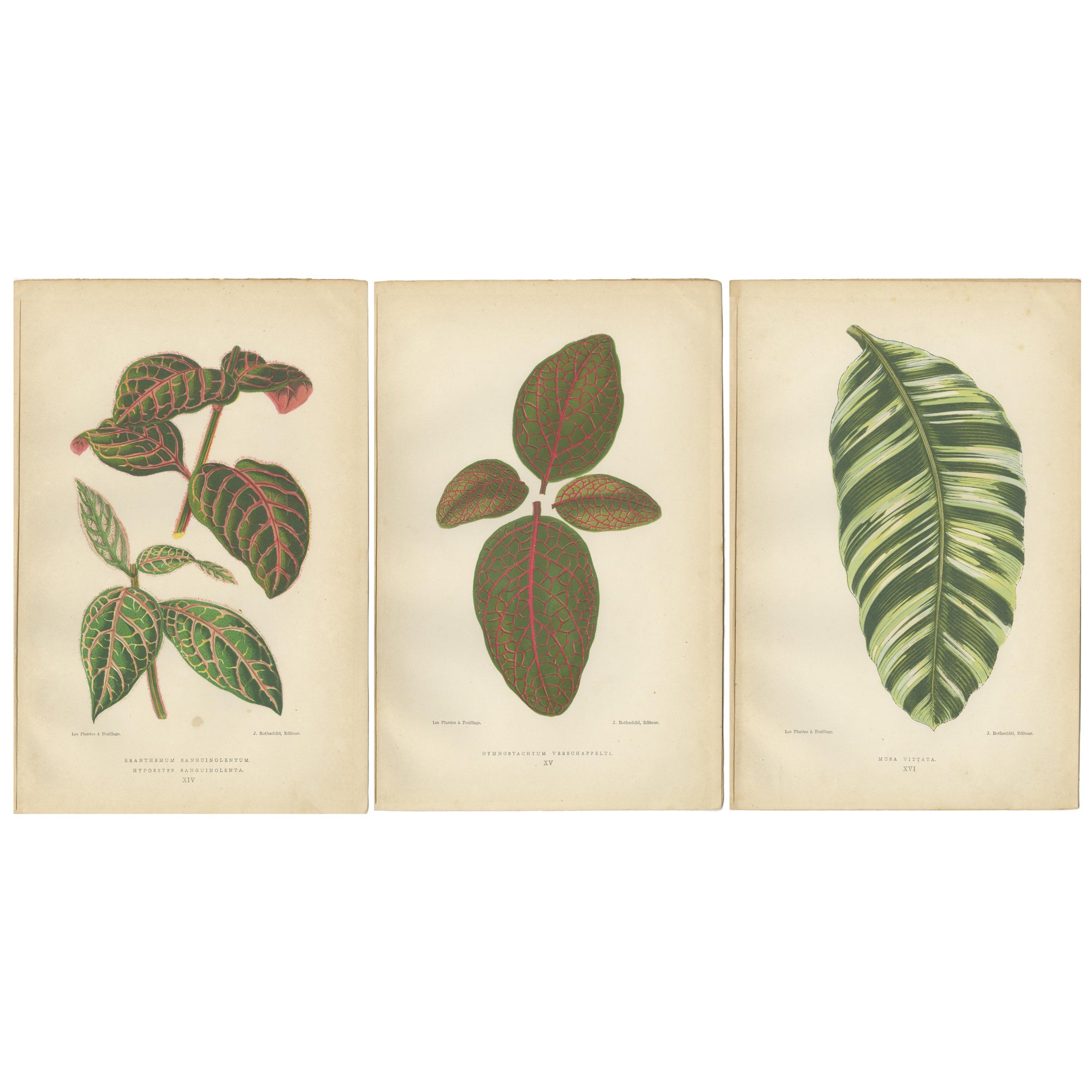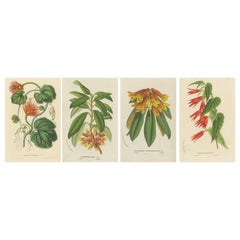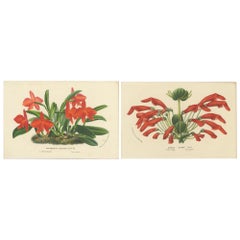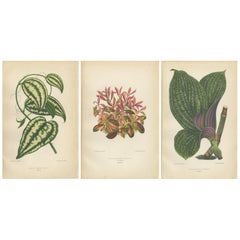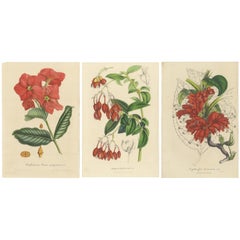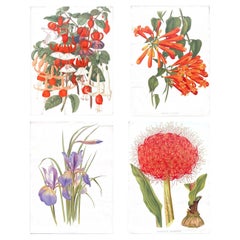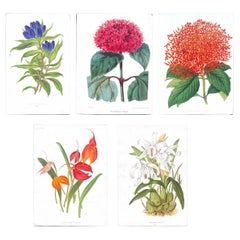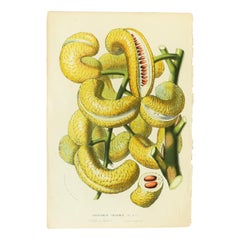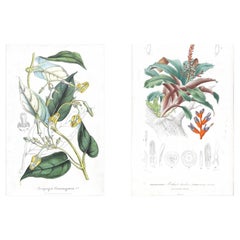Items Similar to Leatherwood Splendor: A Tropical Display of Dircaea Blashii, Published in 1875
Want more images or videos?
Request additional images or videos from the seller
1 of 6
Leatherwood Splendor: A Tropical Display of Dircaea Blashii, Published in 1875
$172.17
$215.2120% Off
£127.46
£159.3220% Off
€144
€18020% Off
CA$238.24
CA$297.8020% Off
A$262.65
A$328.3220% Off
CHF 137.41
CHF 171.7620% Off
MX$3,222.26
MX$4,027.8220% Off
NOK 1,729.74
NOK 2,162.1720% Off
SEK 1,617.58
SEK 2,021.9720% Off
DKK 1,096.90
DKK 1,371.1320% Off
About the Item
The botanical print depicts Dircaea blashii (sometimes labeled as Dircaea or Dirca), a unique flowering plant known for its distinctive, red, tube-shaped flowers which are grouped in a circular, almost parasol-like arrangement around a central, green bulbous structure. This representation is from the "Flore des Serres et des Jardins de l'Europe," indicating it was part of the extensive collection published under the editorial guidance of Louis Van Houtte.
Description of Dircaea blashii:
- Botanical Characteristics: Dircaea blashii is noted for its pendulous, trumpet-shaped flowers that are vivid red and hang gracefully. These plants are usually found in warmer, tropical environments and can be quite striking when in full bloom.
- Flowering and Growth: The arrangement of the flowers around the central axis is quite unique, providing not only a visual spectacle but also an interesting study in plant morphology and reproductive strategies.
Significance:
- Ornamental Value: Due to its unusual floral arrangement and striking color, Dircaea blashii is highly valued as an ornamental plant, making it a sought-after species for collectors and tropical gardens.
- Botanical Interest: Plants like Dircaea blashii are of particular interest in botanical studies due to their unique characteristics and adaptations to their native environments.
Botanical Illustration Insights:
- Chromolithography: This print would have been created using chromolithography, a method especially suited for capturing the vivid hues and delicate gradients of the plant. The technique involves layering several lithographic prints, each with its own color, to produce a final image with depth and intensity.
- Educational and Horticultural Use: As with other prints in Van Houtte’s series, this illustration serves both educational and horticultural purposes, helping to disseminate knowledge about exotic plant species and inspiring interest among European gardeners and horticulturists of the time.
The detailed illustration not only showcases the beauty of Dircaea blashii but also highlights the intersection of art and science that Van Houtte mastered in his botanical publications.
- Dimensions:Height: 6.42 in (16.3 cm)Width: 9.85 in (25 cm)Depth: 0 in (0.02 mm)
- Materials and Techniques:
- Period:
- Date of Manufacture:Circa 1875
- Condition:Condition: Very good, given age. General age-related toning and/or occasional minor defects from handling. Colors are vivid. Please study scan carefully.
- Seller Location:Langweer, NL
- Reference Number:Seller: BG-13761-321stDibs: LU3054341438692
About the Seller
5.0
Recognized Seller
These prestigious sellers are industry leaders and represent the highest echelon for item quality and design.
Platinum Seller
Premium sellers with a 4.7+ rating and 24-hour response times
Established in 2009
1stDibs seller since 2017
2,613 sales on 1stDibs
Typical response time: <1 hour
- ShippingRetrieving quote...Shipping from: Langweer, Netherlands
- Return Policy
Authenticity Guarantee
In the unlikely event there’s an issue with an item’s authenticity, contact us within 1 year for a full refund. DetailsMoney-Back Guarantee
If your item is not as described, is damaged in transit, or does not arrive, contact us within 7 days for a full refund. Details24-Hour Cancellation
You have a 24-hour grace period in which to reconsider your purchase, with no questions asked.Vetted Professional Sellers
Our world-class sellers must adhere to strict standards for service and quality, maintaining the integrity of our listings.Price-Match Guarantee
If you find that a seller listed the same item for a lower price elsewhere, we’ll match it.Trusted Global Delivery
Our best-in-class carrier network provides specialized shipping options worldwide, including custom delivery.More From This Seller
View AllLush and Vibrant: A Collection of Exotic Botanical Illustrations, circa 1875
Located in Langweer, NL
The prints depict a selection of exotic plants with a remarkable detail and vibrant color, showcasing the beauty and diversity of botanical life. Each illustration is a testament to ...
Category
Antique 1870s Prints
Materials
Paper
$392 Sale Price / set
20% Off
Botanical Vintage Prints of Scarlet Sophronitis and Tropical Bloom, c.1845
Located in Langweer, NL
The prints are from Louis Van Houtte's and Charles Lemaire's "Flore des Serres et des Jardins de l'Europe," a detailed collection of botanical lithographs showcasing plants grown in ...
Category
Antique 1840s Prints
Materials
Paper
$229 Sale Price / set
20% Off
Verdant Splendor: Botanical Illustrations of Foliage from 1880
Located in Langweer, NL
The images are botanical illustrations from "Les Plantes à Feuillage Coloré Tome Second," published in Paris in 1880 with J. Rothschild as the editor.
1. The first image depicts a p...
Category
Antique 1880s Prints
Materials
Paper
$229 Sale Price / set
20% Off
Free Shipping
Exquisite Botanical Illustrations from Curtis’s Botanical Magazine (1847)
Located in Langweer, NL
These beautiful hand-colored botanical illustrations, drawn and lithographed by the renowned artist Walter Hood Fitch, were featured in Sir William Jackson Hooker's *"Curtis's Botanical Magazine,"* published in London in 1847. Fitch was one of the most prolific and skilled botanical illustrators of the 19th century, known for his ability to capture the intricate details and vibrant hues of the plants he depicted.
Sir William Jackson Hooker, a famous British botanist and the director of the Royal Botanic Gardens, Kew, commissioned these illustrations as part of his work to document newly discovered plants from around the world. The *Curtis’s Botanical Magazine* has been published since 1787 and remains one of the longest-running botanical periodicals.
Detailed Descriptions of Each Plant
#### 1. **Dipladenia Rosa-campestris** (*Hortul. ex Veitch*)
- **English Name**: Rose Dipladenia
- **Description**: This illustration showcases *Dipladenia rosa-campestris*, a striking flowering plant known for its showy pink to deep red trumpet-shaped flowers. Native to tropical regions of South America, particularly Brazil, *Dipladenia* belongs to the family Apocynaceae and is prized in horticulture for its vibrant blooms and ability to climb. Fitch's illustration emphasizes the waxy leaves and the vivid color of the petals, bringing the plant to life on the page.
#### 2. **Begonia fuchsioides** (*Hook.*)
- **English Name**: Fuchsia-flowered Begonia
- **Description**: The *Begonia fuchsioides* is depicted with its characteristic red, pendulous flowers, which closely resemble the blooms of fuchsia plants. This species of Begonia is native to tropical regions and is popular for its delicate, bell-shaped flowers and glossy leaves. Fitch’s attention to the arrangement of the leaves and the contrast between the flowers' vibrant red and the soft green leaves provides a lifelike representation of this exotic plant.
#### 3. **Agalmyla staminea** (*Blume*)
- **English Name**: Staminate Agalmyla
- **Description**: This illustration captures the unique red tubular flowers of *Agalmyla staminea*, a plant native to Southeast Asia. The species is part of the Gesneriaceae family and is known for its bright, showy flowers that grow in dense clusters. Fitch’s careful rendering of the plant’s leaves and the intricate veining, along with the vibrant red flowers, highlights his talent for bringing the botanical subject to life with both scientific accuracy and artistic flair.
### About the Makers
#### **Walter Hood Fitch** (Artist and Lithographer)
Walter Hood Fitch (1817–1892) was one of the most influential botanical artists of the 19th century, working primarily with Sir William Hooker and later his son, Joseph Dalton Hooker, at Kew Gardens. He produced thousands of illustrations for various botanical publications, including *Curtis’s Botanical Magazine*, where he was responsible for the majority of its plates from 1834 to 1877. Fitch’s mastery of lithography allowed him to create richly detailed and accurate depictions of plants, with a particular talent for illustrating both the botanical structure and the vibrant colors of flowers.
#### **Sir William Jackson Hooker** (Director and Editor)
Sir William Jackson Hooker (1785–1865) was a prominent British botanist and the director of the Royal Botanic Gardens, Kew. Under his leadership, Kew Gardens expanded its collection of plants from around the world, and Hooker was instrumental in promoting the scientific study and illustration of these species. As the editor of *Curtis’s Botanical Magazine*, Hooker collaborated with Fitch to document and share the beauty and diversity of plants with the scientific community and the public.
### The Lithographic Technique
Lithography, particularly chromolithography, was a crucial innovation in botanical illustration. Fitch was skilled in the traditional method of lithography, where an image was drawn onto a stone plate with a greasy substance and then inked for printing. Hand-coloring was often applied afterward to bring the prints to life, as seen in these illustrations. This method allowed for highly detailed, accurate representations of plants and their botanical features, making it invaluable for both scientific study and aesthetic appreciation.
### Conclusion
These prints from *Curtis’s Botanical Magazine* reflect the height of botanical art in the mid-19th century. The combination of Walter Fitch...
Category
Antique 1840s Prints
Materials
Paper
$411 Sale Price / set
20% Off
Original Vintage Botanical Illustrations from Revue Horticole, circa 1855
Located in Langweer, NL
Here are descriptions of the eight botanical illustrations, including the Latin and English names of the plants, why they are significant, and details about the creators and the tech...
Category
Antique 1850s Prints
Materials
Paper
$640 Sale Price / set
20% Off
Botanical Elegance: Masterpieces of Victorian Horticulture, Published in 1880
Located in Langweer, NL
The decorative original antique prints are the second volume of "Les Plantes à Feuillage Coloré", published in Paris in 1880 by J. Rothschild, editor. These images are finely detaile...
Category
Antique 1880s Prints
Materials
Paper
$229 Sale Price / set
20% Off
Free Shipping
You May Also Like
Original 1880s Botanical Print of Hæmanthus Kalbreyeri — Vibrant Antique Chromol
Located in Fukuoka, JP
A striking original chromolithograph from the 1880s, this botanical print features the dramatic Hæmanthus kalbreyeri, also known as the blood lily. Characterized by its intense red s...
Category
Antique 19th Century French Prints
Materials
Paper
Bignonia venusta – Antique Botanical Chromolithograph, 1880s
Located in Fukuoka, JP
A striking original botanical print from the 1880s, featuring Bignonia venusta, also known as flame vine or orange trumpet vine. This brilliantly colored illustration captures the dr...
Category
Antique 19th Century French Prints
Materials
Paper
European Exotic Fruit Botanical Wall Art Litho, circa 19th Century
Located in New York, NY
A very beautiful original Belgian exotic botanical vibrant off-set lithograph, 'Decaisnea Insignis', by artis Horto Van Houtteano, circa 19th century, Belgium. 'Decaisnea Insignis' i...
Category
Antique Late 19th Century Belgian Prints
Materials
Paper
Set of Two Rare Botanical Engravings by D’Orbigny — 1849
Located in Fukuoka, JP
Set of Two Rare Botanical Engravings by D’Orbigny — Dictionnaire Universel d’Histoire Naturelle, Paris, 1849
An exquisite pair of original hand-colored botanical engravings from the...
Category
Antique 19th Century French Prints
Materials
Paper
Antique Botanical Plate Boehmeria tenacissima Bohemian Manufacture of the 1930s
Located in Milan, IT
Colored lithograph applied on light cardboard depicting botanical study with various sections of Boehmeria tenacissima Roxb and of Corchorus capsularis L. Bohemian manufacture of the...
Category
Vintage 1930s Czech Prints
Materials
Paper
Antholyza Fulgens. Henry Andrews antique botanical flower engraving print
By Henry C Andrews
Located in Melbourne, Victoria
'Antholyza Fulgens - Refulgent-flowered Antholyza'
Original copper-line engraving with original hand-colouring from Henry Andrews' 'The Botanist's Repository', 1797-1812. Accompani...
Category
Early 19th Century Naturalistic Still-life Prints
Materials
Engraving
